Jan Plug
On the Brink: Language, Time, History, and Politics
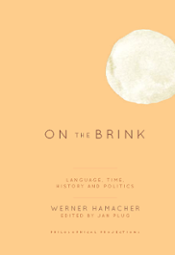 By (author) Werner Hamacher
By (author) Werner Hamacher
Edited by Jan Plug
This collection of essays by one of the foremost figures in contemporary theory takes as its theme the edge or limit between language, time, history, and politics. These are essays that are all on the brink, the very extreme at which one can no longer define where one is located, neither on the cliff, say, nor over the edge. To be on the brink is to take up that extreme limit, the point of contamination or indetermination where language, time, history, and politics all converge upon one another.
On the Brink begins with a consideration of Kant’s treatment of time as representation and of Hegel’s treatment of the writing of history and the end of art, all while taking up other key figures in the history of philosophy. The book then moves to an exploration of language in a variety of manifestations, from translation to complaint and greeting. It concludes by analyzing political and social questions that continue to haunt us today—the conception of work, not least in National Socialism, and our relationship to democracy. Taken together, Werner Hamacher’s essays offer trenchant historical, political, and rhetorical interventions into the history of philosophy, literature, and our contemporary political situation. 2020, Rowman and Littlefield.
The Supermaket of the Visible
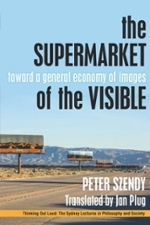 By (author) Peter Szendy
By (author) Peter Szendy
Translated by Jan Plug
Already in 1929, Walter Benjamin described “a one hundred per cent image-space.” Such an image space saturates our world now more than ever, constituting the visibility in which we live. The Supermarket of the Visible analyzes this space and the icons that populate it as the culmination of a history of the circulation and general commodification of images and gazes. From the first elevators and escalators (tracking shots avant la lettre) to cinema (the great conductor of gazes), all the way down to contemporary eye-tracking techniques that monitor the slightest saccades of our eyes, Peter Szendy offers an entirely novel theory of the intersection of the image and economics.
The Supermarket of the Visible elaborates an economy proper to images, icons, in other words, an iconomy. Deleuze caught a glimpse of this when he wrote that “money is the back side of all the images that cinema shows and edits on the front.” Since “cinema,” for Deleuze, is synonymous with “universe,” Szendy argues that this sentence must be understood in its broadest dimension and that a reading of key works in the history of cinema allows us a unique vantage point upon the reverse of images, their monetary implications. Paying close attention to sequences in Hitchcock, Bresson, Antonioni, De Palma, and The Sopranos, Szendy shows how cinema is not a uniquely commercial art form among other, purer arts, but, more fundamentally, helps to elaborate what might be called, with Bataille, a general iconomy.
Moving deftly and lightly between political economy, aesthetic theory, and popular movies and television, The Supermarket of the Visible will be a necessary book for anyone concerned with media, philosophy, politics, or visual culture. 2019, Fordham University Press.
Of Stigmatology
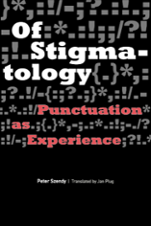 Of Stigmatology elaborates for the first time a general theory of punctuation. Beginning with punctuation marks in
Of Stigmatology elaborates for the first time a general theory of punctuation. Beginning with punctuation marks in
Repeatedly, what Szendy finds in these works is a punctuation that marks experience itself, that seeks (and ultimately fails) to bind the subject to itself. This is the
They Have All Been Healed: Reading Robert Walser
 Where do the characters in Robert Walser’s works come from? The question is posed by Walter Benjamin, who quickly provides an answer in what remains the most provocative reading of the
Where do the characters in Robert Walser’s works come from? The question is posed by Walter Benjamin, who quickly provides an answer in what remains the most provocative reading of the
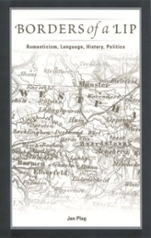 Borders of a Lip: Romanticism, Language, History, Politics
Borders of a Lip: Romanticism, Language, History, Politics
This book recasts questions about the overlapping boundaries of language, history, and politics that have been at the
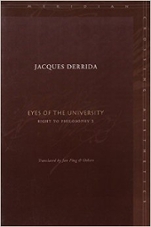 Eyes of the University: Right to Philosophy 2 (trans.)
Eyes of the University: Right to Philosophy 2 (trans.)
Completing the translation of Derrida's monumental work Right to Philosophy (the first part of which has already appeared under the title of Who's Afraid of Philosophy?), Eyes of the University brings together many of the philosopher's most important texts on the university and, more broadly, on the languages and institutions of philosophy.
In addition to considerations of the implications for literature and philosophy of French becoming a state language, of Descartes' writing of the Discourse on Method in French, and of Kant's and Schelling's philosophies of the university, the volume reflects on the current state of research and teaching in philosophy and on the question of what Derrida calls a "university responsibility." 2004, Stanford University Press.
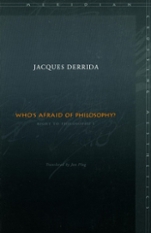 Who’s Afraid of Philosophy?: Right to Philosophy 1 (trans.)
Who’s Afraid of Philosophy?: Right to Philosophy 1 (trans.)
This volume reflects Jacques Derrida's engagement in the late 1970s with French political debates on the teaching of philosophy and the reform of the French university system. He was a founding member of the Research Group on the Teaching of Philosophy (
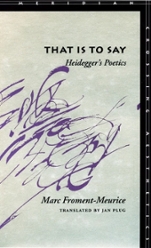 That is to Say: Heidegger's Poetics (trans.)
That is to Say: Heidegger's Poetics (trans.)
This is the first authoritative, book-length study of what Heidegger called "thinking poetics." That Is to



